2020 Annual Report for: Coleophoridae / Coleophorinae
For species seen in 2020 that had less than or equal to 100 records, full details are included; for more common species, the earliest, latest and highest count by vice-county are shown. The narrative for each species is taken from the main Hantsmoths website, and it is possible that some information on abundance and occurrence can get out of date, as it is impossible to keep up with all changes; however it should give a good introduction to each species. The tables in each species account summarise the previous status, and that for the current year.
For the maps, all records prior to 2020 are shown by a blue dot (the larger the dot, the more recent), with the current year's records shown in red. As previous records are superimposed on any report for 2020, new sites have greater emphasis (i.e. will show as 'more red').
In the species accounts, an asterisk next to a location indicates a new 10km square record; earliest ever dates are highlighted in orange, and latest ever in red. Initials in the species accounts refer to the recorders listed here. Please get in touch if you identify any omissions or errors, in particular if you have records that have yet to be submitted. Details of how to submit records can be found here.
37.002 [B&F: 0487] Coleophora lutarea (Haworth, 1828) - Local
Local in open woodland in southern England and south Wales. Reported from scattered locations in Hampshire, and only common in recent years from Pamber Forest: the Isle of Wight saw no records between the first in 1929, and 2012, when larvae were found in some numbers at Godshill. One was also seen in Firestone Copse in 2014. It is probably overlooked, and it may be found in new areas by searching for the adult moth which often rests on the flowers of the foodplant in sunshine, feeding on the nectar. The larva feeds within seeds of Greater Stitchwort, living within a movable case. Adult wingspan 9-11 mm.
Records prior to 2020
| Vice County | #Records | #Individuals | First Record | Last Record |
|---|---|---|---|---|
| 10 | 5 | 2 | 1929 | 2014 |
| 11 | 27 | 51 | 1975 | 2017 |
| 12 | 28 | 75 | 1991 | 2019 |
2020 records
| Vice County | #Records | #Individuals | Max Quantity |
|---|---|---|---|
| 11 | 1 | 0 | 0 |
| 12 | 5 | 16 | 5 |

Records by year
Records by week (adult)
Records by week (larval)
Record Details
VC11: Woodlands, New Forest*, present, field observation, 08 May (RBW);
VC12: Pamber Forest, five, field observation, on greater stitchwort flowers, 23 Apr; four, netted, 20 May; one, field observation, 23 Apr; Lower Inhams Copse, Pamber, two, field observation, swept from stitchwort, 14 May; Pamber Forest, four, field observation, 23 Apr (GJD); Odiham Common, one, netted, ♀, gen det, 19 May (JHH, AMD det. AMD)
37.003 [B&F: 0488] Coleophora limoniella (Stainton, 1884) - Nationally Scarce B
Nationally scarce (Nb) in saltmarshes throughout much of south-eastern England, with records north to Lincolnshire. Common in the salt-marshes of the Isle of Wight and southern Hampshire. Wingspan 10-11 mm. Imago fairly distinctive with its silver metallic markings; it comes readily to light and may be netted at dusk over its foodplant. Larva feeds within flowers and seedheads of Common Sea-lavender, living within a movable case, which can be quite easy to find amongst the foodplant.
Records prior to 2020
| Vice County | #Records | #Individuals | First Record | Last Record |
|---|---|---|---|---|
| 10 | 21 | 86 | 1900 | 2019 |
| 11 | 65 | 82 | 1982 | 2019 |
2020 records
| Vice County | #Records | #Individuals | Max Quantity |
|---|---|---|---|
| 11 | 2 | 2 | 1 |
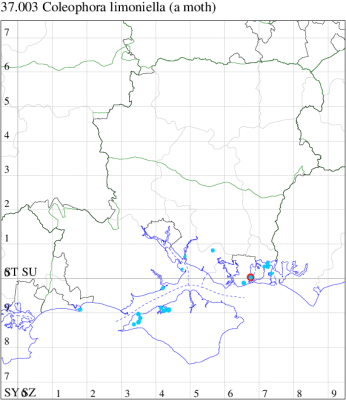
Records by year
Records by week (adult)
Records by week (larval)
Record Details
VC11: Portsmouth, one, 24 Jun; one, 25 Jun (IRT)
37.005 [B&F: 0490] Coleophora lutipennella (Zeller, 1838) - Common
Common in oak woodland, woodland rides and areas with scattered trees throughout much of England, Wales and southern Scotland. In Hampshire and on the Isle of Wight common and widespread. Wingspan 10-12 mm. Imago very similar to C. flavipennella. Like many of the Coleophora, imagines are virtually impossible to identify without recourse to dissection, and the larvae, which live in cases of characteristic form and which can sometimes be found on the foodplant, may be easier to identify by comparison against a reference collection. Larva mines leaves of Oak, living within a movable case, which differs from that of C. flavipennella in having leaf material at the back end of the case.
Records prior to 2020
| Vice County | #Records | #Individuals | First Record | Last Record |
|---|---|---|---|---|
| 10 | 3 | 1 | 2007 | 2018 |
| 11 | 209 | 272 | 1969 | 2019 |
| 12 | 41 | 31 | 1994 | 2019 |
2020 records
| Vice County | #Records | #Individuals | Max Quantity |
|---|---|---|---|
| 11 | 1 | 2 | 2 |

Records by year
Records by week (adult)
Records by week (larval)
Record Details
VC11: Catisfield, two, to actinic, gen det, 25 Jun (ALR det. RJD);
VC12: Yateley*, one, ♂, gen det, 23 Jun (JHH det. AMD)
37.007 [B&F: 0492] Coleophora flavipennella (Duponchel, [1843]) - Common
Common in oak woodland, woodland rides and areas with scattered trees throughout much of England and Wales; rare in Ireland and Scotland. In Hampshire and on the Isle of Wight common and widespread. Wingspan 10.5-12.5 mm. Imago very similar to C. lutipennella. Like many of the Coleophora, imagines are virtually impossible to identify without recourse to dissection, and the larvae, which live in cases of characteristic form and which can sometimes be found on the foodplant, may be easier to identify by comparison against a reference collection. Larva mines leaves of Oak, living within a movable case, , which differs from that of C. lutipennella in having no leaf material at the back end of the case.
Records prior to 2020
| Vice County | #Records | #Individuals | First Record | Last Record |
|---|---|---|---|---|
| 10 | 14 | 2 | 1999 | 2014 |
| 11 | 205 | 227 | 1973 | 2019 |
| 12 | 35 | 34 | 1971 | 2015 |
2020 records
| Vice County | #Records | #Individuals | Max Quantity |
|---|---|---|---|
| 11 | 2 | 2 | 1 |

Records by year
Records by week (adult)
Records by week (larval)
Record Details
VC11: Pig Bush, NF, one, gen det, 17 Jul (CL); Wickham, one, ♂, gen det, 07 Aug (F.M.G.)
37.012 [B&F: 0499] Coleophora limosipennella (Duponchel, [1843]) - Local
Local in woodland margins and hedgerows throughout much of south-eastern England, north to Yorkshire. In Hampshire most frequent in the south-east of the county, with scattered records elsewhere and on the Isle of Wight. Wingspan 10-13.5 mm. The main confusion species are C. milvipennis and C. alnifoliae, which have the antenna unringed at the apex, and C. badiipennella, which is smaller. Larva mines leaves of Elm, living within a movable case, and over-wintering twice; case length 9-11.5 mm.
Records prior to 2020
| Vice County | #Records | #Individuals | First Record | Last Record |
|---|---|---|---|---|
| 10 | 9 | 2 | 1900 | 2014 |
| 11 | 37 | 18 | 1978 | 2017 |
| 12 | 2 | 3 | 1984 | 1997 |
2020 records
| Vice County | #Records | #Individuals | Max Quantity |
|---|
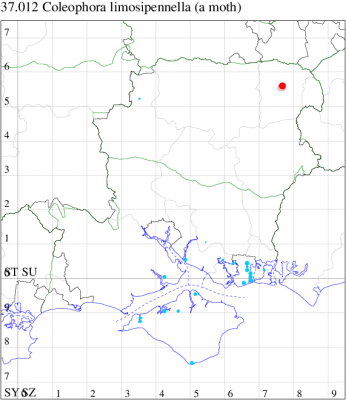
Records by year
Records by week (adult)
Records by week (larval)
Record Details
VC12: Hartley Wintney*, larva, one, field observation, larval case on Elm (Ulmus procera), 16 Nov (JHH)
37.015 [B&F: 0493] Coleophora serratella (Linnaeus, 1761) - Common
Common in woodland, hedgerows, heathland and fens throughout much of the British Isles, except for the Outer Hebrides, Orkney and Shetland. In Hampshire and on the Isle of Wight common and widespread. Wingspan 10.5-14 mm. Like many of the Coleophora, imagines are virtually impossible to identify without recourse to dissection, and the larvae, which live in cases of characteristic form and which can sometimes be found on the foodplant, may be easier to identify by comparison against a reference collection. Larva mines leaves of Birch, Alder, Elm and Hazel, living within a movable case.
Records prior to 2020
| Vice County | #Records | #Individuals | First Record | Last Record |
|---|---|---|---|---|
| 10 | 91 | 50 | 1900 | 2018 |
| 11 | 435 | 344 | 1972 | 2019 |
| 12 | 110 | 70 | 1974 | 2014 |
2020 records
| Vice County | #Records | #Individuals | Max Quantity |
|---|---|---|---|
| 10 | 4 | 5 | 2 |
| 11 | 1 | 1 | 1 |
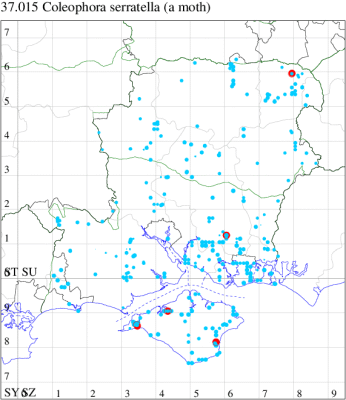
Records by year
Records by week (adult)
Records by week (larval)
Record Details
VC10: Afton Marsh, two, field observation, feeding On Birch, 12 May (SDa); Walter's Copse, larva, one, field observation, larval case on English Elm, 17 May; Shanklin, one, gen det, 06 Jul; one, 30 Jul (IOu);
VC11: West Walk, case, one, on host-plant, old case on birch, 28 Sep (RJD);
VC12: Castle Bottom NNR, larva, present, field observation, larval case on birch, 01 May (JHH)
37.016 [B&F: 0495] Apple & Plum Case-bearer Coleophora spinella (Schrank, 1802) - Common
Common in open woodland, scrubland, orchards, gardens and hedgerows throughout much of England and Wales; rare in Ireland. In Hampshire and on the Isle of Wight widespread and common. Wingspan 10.5-12 mm. Imago separable from C. coracipennella and C. prunifoliae only by dissection of the genitalia. Larva mines leaves of Hawthorn and Apple, living within a movable case; no feature is known for distinguishing cases of the three species, and the moths must therefore be bred and dissected, although cases on Hawthorn are more likely to be those of C. spinella.
Records prior to 2020
| Vice County | #Records | #Individuals | First Record | Last Record |
|---|---|---|---|---|
| 10 | 24 | 3 | 1856 | 2014 |
| 11 | 251 | 185 | 1972 | 2019 |
| 12 | 26 | 16 | 1987 | 2016 |
2020 records
| Vice County | #Records | #Individuals | Max Quantity |
|---|---|---|---|
| 11 | 2 | 2 | 1 |
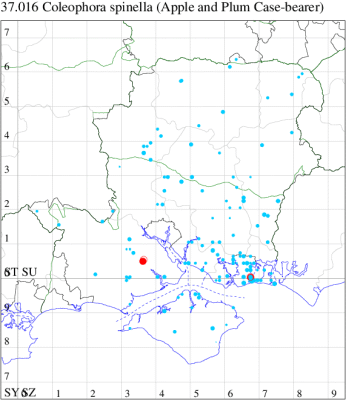
Records by year
Records by week (adult)
Records by week (larval)
Record Details
VC11: Pig Bush, NF, one, gen det, 17 Jul (CL); Portsmouth, one, gen det, 18 Jul (IRT)
37.027 [B&F: 0513] Coleophora potentillae Elisha, 1885 - Local
Local in rough grassland, damp woodland, fens, ditches and woodland rides in England, south of a line from Lincolnshire to Herefordshire, central and western Scotland, and western Ireland. In Hampshire and on the Isle of Wight there are scattered records throughout, but most frequent at Leckford, Botley Wood, Teg Down and Emer Bog. Wingspan 8-9.5 mm. Like many of the Coleophora, imagines are virtually impossible to identify without recourse to dissection, and best identified in the field, where in Hampshire the larvae are mainly found on rosaceous herbs and shrubs. Foodplants are wide ranging, quoted as including Agrimonia (Agrimony), Filpendula ulmaria (Meadowsweet), Fragaria vesca (Wild Strawberry), Geum spp (Avens), Potentilla spp. (Cinquefoils), Rosa spp. (Rose), Rubus sp (brambles). and also Crataegus (Hawthorn), Betula (Birch), Prunus spinosa (Blackthorn) and Helianthemum (Rock Rose). The case resembles that of C.violacea, but does not lie so flat again the leaf as this species (having a mouth angle of 30 to 50°). C.violacea also has a case which bulges in the middle, whereas in C.potentillae the case tapers towards the posterior.
Records prior to 2020
| Vice County | #Records | #Individuals | First Record | Last Record |
|---|---|---|---|---|
| 10 | 7 | 3 | 1938 | 2003 |
| 11 | 35 | 21 | 1978 | 2019 |
| 12 | 6 | 2 | 1987 | 2013 |
2020 records
| Vice County | #Records | #Individuals | Max Quantity |
|---|

Records by year
Records by week (adult)
Records by week (larval)
Record Details
VC12: Yateley Common, larva, two, field observation, occupied cases on Bramble (Rubus fruticosus agg.), 24 Nov; larva, three, field observation, occupied cases on Bramble (Rubus fruticosus agg.), 29 Nov (JHH)
37.032 [B&F: 0515] Coleophora albitarsella Zeller, 1849 - Local
Local in hedgerows, open woodland, fens and downland throughout much of England and Wales, more numerous in the south. In Hampshire and on the Isle of Wight there are scattered records throughout, with no apparent population centre. Wingspan 10-13 mm. The pale tarsi that gives the species its scientific name are a ready means of recognition. Larva mines leaves of Wild Basil, Wild Marjoram, Self-heal, Ground-ivy and Mint, living within a movable case; case length 9 mm.
Records prior to 2020
| Vice County | #Records | #Individuals | First Record | Last Record |
|---|---|---|---|---|
| 10 | 34 | 15 | 1902 | 2018 |
| 11 | 78 | 81 | 1978 | 2019 |
| 12 | 55 | 61 | 1985 | 2018 |
2020 records
| Vice County | #Records | #Individuals | Max Quantity |
|---|---|---|---|
| 10 | 3 | 3 | 1 |
| 11 | 1 | 2 | 2 |
| 12 | 3 | 3 | 1 |
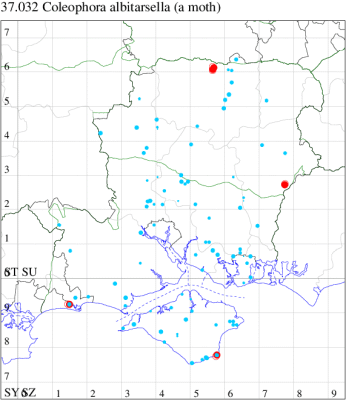
Records by year
Records by week (adult)
Records by week (larval)
Record Details
VC10: Bonchurch, one, 07 Jun; one, 19 Jun; one, 12 Jul (JHa);
VC11: Tuckton, Bournemouth, two, 30 Jul (APar);
VC12: Axmansford*, one, 23 Jul; one, 13 Jul (ACB); Liss*, one, 17 Jul (LBe)
37.033 [B&F: 0516] Coleophora trifolii (Curtis, 1832) - Local
Local on rough grassland, waste ground and roadside verges throughout much of the British Isles, less numerous in Scotland, more numerous in the south. In Hampshire widely but thinly distributed, records increasing in recent years; on the Island still rarely reported. Wingspan 15-20 mm. The comparatively large size, metallic green forewings with copper apex and white tip to antennae, make this species one of the few which can be identified without recourse to dissection of the genitalia, although the differences in size between this and other related species may only be obvious in series of mounted, set specimens. Larva feeds within seedpods of Ribbed Melilot and Tall Melilot, living within a movable case.
Records prior to 2020
| Vice County | #Records | #Individuals | First Record | Last Record |
|---|---|---|---|---|
| 10 | 39 | 41 | 1856 | 2018 |
| 11 | 183 | 240 | 1972 | 2019 |
| 12 | 118 | 155 | 1993 | 2019 |
2020 records
| Vice County | #Records | #Individuals | Max Quantity |
|---|---|---|---|
| 10 | 4 | 5 | 2 |
| 11 | 26 | 23 | 1 |
| 12 | 1 | 1 | 1 |

Records by year
Records by week (adult)
Records by week (larval)
Record Details
VC10: Shanklin, one, 15 Jun; one, 25 Jun; two, 09 Aug; one, 23 Aug (IOu);
VC11: Furze Hill, NF, present, 19 Jul (RBW, MWa); one, 20 Jul; Woodlands, New Forest, present, 21 May (RBW); Ashurst, NF, one, 08 Aug (SAB); Totton, one, 09 Aug (LH); Winchester, one, 14 Aug; one, 14 Sep (THW); Catisfield, one, 10 Aug (ALR); Fareham, one, 19 May (IMcP); Botley, one, to actinic, 15 Jul; one, to actinic, 17 Jul; one, to actinic, 11 Aug; one, to actinic, 20 Jun; one, to actinic, 18 Jul; one, to actinic, 26 Jul; one, to actinic, 02 Aug; one, to actinic, 07 Aug; one, to actinic, 08 Aug; one, to actinic, 11 Aug; one, to actinic, 13 Aug; one, to actinic, 15 Aug (SLB); Hilltop, The Hangers, one, 01 Aug (SI); Portsmouth, one, 23 Jun (IRT); Sway, one, 27 May; two, 02 Jun; one, 21 Jun; one, 02 Jul (SKe); Milford on Sea, one, 08 Jun (MMcM); Norleywood, NF, present, 09 Aug (RBW, MWa);
VC12: Cholderton, one, 24 Jul (TJN, HE); Farnborough, one, 23 Jul (KBW)
37.035 [B&F: 0517] Clover Case-bearer Coleophora alcyonipennella (Kollar, 1832) - Local
Local on rough grassland and waste ground, although the exact status and distribution of this species is unclear due to past confusion with C. frischella, which is very similar and can only be separated through dissection of the genitalia. In Hampshire widespread and almost certainly under-recorded; this is certainly the case on Wight, where it was determined for the first time at Totland in 2021 and found to be common at the same site in 2022. Wingspan 11.5-14.5 mm. Larva feeds within seedheads of White Clover, living within a movable case.
Records prior to 2020
| Vice County | #Records | #Individuals | First Record | Last Record |
|---|---|---|---|---|
| 11 | 456 | 600 | 1973 | 2019 |
| 12 | 54 | 73 | 1994 | 2019 |
2020 records
| Vice County | #Records | #Individuals | Max Quantity |
|---|---|---|---|
| 11 | 21 | 23 | 2 |
| 12 | 3 | 3 | 1 |

Records by year
Records by week (adult)
Records by week (larval)
Record Details
VC11: Totton, one, 16 May; one, 18 May; one, 20 May; one, 30 May; one, 13 Jun (LH); Fareham, one, to actinic, gen det, 17 Jul; one, to actinic, not dissected, 11 Aug; one, to actinic, not dissected, 15 Sep (MLO); Portsmouth, one, 24 May; one, 08 Jun; one, 17 Jun; one, 25 Jun; one, 07 Jul; one, 12 Jul; one, 18 Jul; one, 19 Jul; one, 04 Aug; two, 10 Aug; one, 12 Aug; two, 13 Aug; one, 20 Aug (IRT);
VC12: Basingstoke, one, 01 Jun (MJW); Liss Forest, one, 17 May; Warren Hill, Liss Forest, one, 15 Aug (RJM); Up Green Wood, Eversley*, one, netted, ♀, gen det, 07 May; Yateley*, two, ♂, gen det, 17 Aug (JHH det. AMD)
37.036 [B&F: 0521] Coleophora conyzae Zeller, 1868 - Nationally Scarce B
Nationally scarce (Nb) in chalk downland and freshwater margins in parts of southern England and southern Wales. In Hampshire mainly confined to the south-east, with just a handful of records in the north of the county and on the Isle of Wight. Wingspan 12-16 mm. Like many of the Coleophora, imagines are virtually impossible to identify without recourse to dissection, and the larvae, which live in cases of characteristic form and which can sometimes be found on the foodplant, may be easier to identify by comparison against a reference collection. Larva mines leaves of Ploughman's-spikenard and Common Fleabane, living within a movable case.
Records prior to 2020
| Vice County | #Records | #Individuals | First Record | Last Record |
|---|---|---|---|---|
| 10 | 13 | 11 | 1900 | 2019 |
| 11 | 104 | 112 | 1967 | 2019 |
| 12 | 1 | 1 | 2011 | 2011 |
2020 records
| Vice County | #Records | #Individuals | Max Quantity |
|---|

Records by year
Records by week (adult)
Records by week (larval)
Record Details
VC11: Chandlers Ford*, one, 17 Jul; one, 17 Jul (BE)
37.038 [B&F: 0522] Coleophora lineolea (Haworth, 1828) - Local
Local in hedgerows and waste ground throughout much of southern England and Wales, with records north to Yorkshire. In Hampshire the majority of records are from Portsea and Hayling Islands, with scattered records elsewhere across our two counties. Wingspan 11-14.5 mm. Candidates for this species can be picked out by the yellow-ochreous wing veins, but is more easily verified at the larval stage with its distinctive case made of rings of mined leaf, fully developed in May. Larva mines leaves of labiates, in particular Hedge Woundwort and Black Horehound, but also uses White Horehound and Betony.
Records prior to 2020
| Vice County | #Records | #Individuals | First Record | Last Record |
|---|---|---|---|---|
| 10 | 16 | 14 | 1977 | 2019 |
| 11 | 270 | 321 | 1972 | 2019 |
| 12 | 11 | 6 | 1984 | 2010 |
2020 records
| Vice County | #Records | #Individuals | Max Quantity |
|---|---|---|---|
| 11 | 12 | 14 | 2 |
| 12 | 1 | 1 | 1 |

Records by year
Records by week (adult)
Records by week (larval)
Record Details
VC11: Chandlers Ford, one, 14 Jul; one, 14 Jul (BE); Catisfield, one, 06 Aug (ALR det. RJD); Portsmouth, one, gen det, 02 Jun; one, 18 Jul; one, 01 Aug; one, 02 Aug; two, 03 Aug; two, 06 Aug; one, 07 Aug; one, 08 Aug; one, 12 Aug; one, gen det, 26 Aug (IRT);
VC12: Basingstoke, one, 31 Jul (MJW)
37.042 [B&F: 0545] Coleophora saturatella Stainton, 1850 - pRDB3
Rare (proposed as a future Red Data Book species) on heathland, open woodland and rough pastures in parts of south-eastern England. In Hampshire and on the Isle of Wight recorded very occasionally, and reported from Blackbushe Airfield in the north in 2020. Wingspan 12-15 mm. The main confusion species is C. genistae, but that species has the ground colour of the forewing paler and more ochreous and the costal streak reaching almost to the apex (MBGBI Vol 3). Larva mines leaves of Broom and Dyer's Greenweed, living within a movable case; case length 8 mm.
Records prior to 2020
| Vice County | #Records | #Individuals | First Record | Last Record |
|---|---|---|---|---|
| 10 | 3 | 0 | 1900 | 1929 |
| 11 | 5 | 2 | 1990 | 2011 |
2020 records
| Vice County | #Records | #Individuals | Max Quantity |
|---|

Records by year
Records by week (adult)
Records by week (larval)
Record Details
VC12: New Vice-county Record: Blackbushe Airfield*, larva, one, field observation, a single old case on Broom (Cysticus), 19 Nov; larva, three, field observation, on Broom, 08 Jun; larva, four, field observation, found on Broom (2 collected but failed to rear; 1x parasitised by hymenopteran), 02 Jul (JHH)
37.044 [B&F: 0547] Coleophora discordella Zeller, 1849 - Common
Common in rough grassland, downland and woodland clearings and in marshes and other damp places throughout much of the British Isles, except the Shetland Islands. In Hampshire and on the Isle of Wight rather infrequently recorded, with the usual concentration of records in the south-east of the county, probably under-recorded elsewhere. Wingspan 11-12.5 mm. Like many of the Coleophora, imagines are virtually impossible to identify without recourse to dissection, and the larvae, which live in cases of characteristic form and which can sometimes be found on the foodplant, may be easier to identify by comparison against a reference collection. Larva mines leaves of Common Bird's-foot Trefoil and Greater Bird's-foot Trefoil, living within a movable case.
Records prior to 2020
| Vice County | #Records | #Individuals | First Record | Last Record |
|---|---|---|---|---|
| 10 | 12 | 4 | 1850 | 2018 |
| 11 | 45 | 44 | 1977 | 2018 |
| 12 | 5 | 4 | 1971 | 2011 |
2020 records
| Vice County | #Records | #Individuals | Max Quantity |
|---|---|---|---|
| 10 | 1 | 1 | 1 |
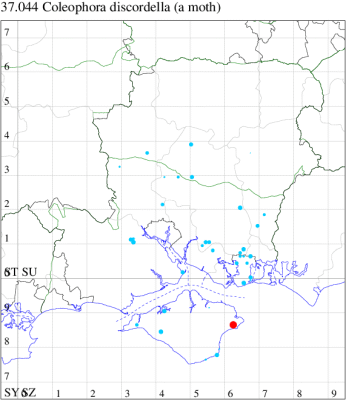
Records by year
Records by week (adult)
Records by week (larval)
Record Details
VC10: Bembridge Fort*, one, gen det, 06 Aug (IOu)
37.046 [B&F: 0519] Coleophora deauratella Lienig & Zeller, 1846 - Local
Local on waste ground, grassland and roadside verges throughout S. England and S. Wales. In Hampshire recorded fairly frequently only in the south-east, but the true distribution poorly known due to confusion with other related species. Not recorded from the Isle of Wight since 1900. Wingspan 10.5-12.5 mm. Day-flying, but comes to light, although less frequently than other related species. Can be separated from C. alcyonipennella and C. frischella only by dissection of the genitalia. Larva feeds within seedheads of Red Clover, living within a movable case; case length 6 mm.
Records prior to 2020
| Vice County | #Records | #Individuals | First Record | Last Record |
|---|---|---|---|---|
| 10 | 4 | 3 | 1900 | 2019 |
| 11 | 130 | 137 | 1972 | 2019 |
| 12 | 25 | 43 | 1986 | 2011 |
2020 records
| Vice County | #Records | #Individuals | Max Quantity |
|---|---|---|---|
| 10 | 2 | 2 | 1 |
| 11 | 6 | 6 | 1 |

Records by year
Records by week (adult)
Records by week (larval)
Record Details
VC10: Shanklin, one, gen det, 07 Jun; one, gen det, 20 Sep (IOu);
VC11: Portsmouth, one, 17 Jun; one, 19 Jun; one, 25 Jun; one, 30 Jul; one, 08 Aug; one, 10 Aug (IRT)
37.048 [B&F: 0518] Coleophora mayrella (Hübner, [1813]) - Common
Common on grassland, roadside verges and waste ground throughout much of the British Isles. In Hampshire reported at light across much of the county, but no recent records from the Isle of Wight. Wingspan 10.5-12 mm. Like many of the Coleophora, imagines are virtually impossible to identify without recourse to dissection, and the larvae, which live in cases of characteristic form and which can sometimes be found on the foodplant, may be easier to identify by comparison against a reference collection. Larva feeds within seedheads of White Clover, living within a movable case, and can be collected and bred through as described in MBGBI Vol 3.
Records prior to 2020
| Vice County | #Records | #Individuals | First Record | Last Record |
|---|---|---|---|---|
| 10 | 8 | 5 | 1930 | 2019 |
| 11 | 138 | 155 | 1973 | 2019 |
| 12 | 79 | 107 | 1990 | 2018 |
2020 records
| Vice County | #Records | #Individuals | Max Quantity |
|---|---|---|---|
| 10 | 1 | 1 | 1 |
| 11 | 6 | 6 | 1 |
| 12 | 2 | 2 | 1 |

Records by year
Records by week (adult)
Records by week (larval)
Record Details
VC10: Shanklin, one, gen det, 08 Jun (IOu);
VC11: Southampton, one, 20 Jul (MEdg); Portsmouth, one, 01 Jun; one, 08 Jun; one, 17 Jun; one, 18 Jun; one, 19 Jun; one, 23 Jun (IRT);
VC12: Basingstoke, one, 24 Jun; one, 26 Jun (MJW)
37.049 [B&F: 0533] Pistol Case-bearer Coleophora anatipennella (Hübner, 1796) - Local
Local in scrubland, hedgerows, parks and gardens in southern England and Wales; rare elsewhere. In Hampshire virtually restricted to the south coast in the east of the county, very rare inland or in the west; on the Isle of Wight, the few records have all been on the north coast. Wingspan 12.5-17 mm. Like many of the Coleophora, imagines are virtually impossible to identify without recourse to dissection, and the larvae, which live in cases of characteristic form and which can sometimes be found on the foodplant, may be easier to identify by comparison against a reference collection. Larva mines leaves of Blackthorn, and also Wild Cherry, Hawthorn, Apple, Pear and Rowan, living within a movable pistol-case.
Records prior to 2020
| Vice County | #Records | #Individuals | First Record | Last Record |
|---|---|---|---|---|
| 10 | 13 | 9 | 1998 | 2019 |
| 11 | 100 | 88 | 1975 | 2019 |
| 12 | 14 | 18 | 1994 | 2011 |
2020 records
| Vice County | #Records | #Individuals | Max Quantity |
|---|---|---|---|
| 10 | 1 | 0 | 0 |
| 11 | 1 | 1 | 1 |
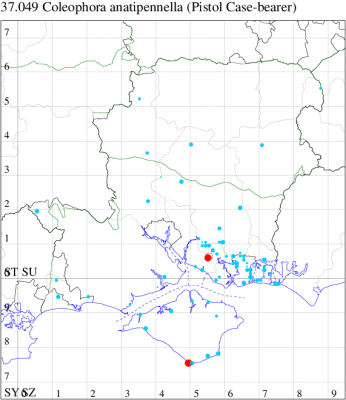
Records by year
Records by week (adult)
Records by week (larval)
Record Details
VC10: St Catherine's Point*, mine, present, blackthorn leaves with numerous tiny windows from early stages of anatipennella larva, 01 Oct (IOu);
VC11: Catisfield, one, to actinic, gen det, 25 Jun (ALR det. RJD)
37.050 [B&F: 0532] Coleophora albidella ([Denis & Schiffermüller], 1775) - Local
Local in fens, bogs, damp woodland, marshes, river-banks and damp areas throughout much of England and Wales, most frequently in the west; rare in Ireland. In Hampshire and on the Isle of Wight, it appears be nowhere frequent even in appropriate habitat, with the cases hard to find and most records relate to adults at light that have been critically examined. The larva feeds within buds of Grey Willow, Eared Willow and Creeping Willow, preferring young trees, living within a distinctive curled case.
Records prior to 2020
| Vice County | #Records | #Individuals | First Record | Last Record |
|---|---|---|---|---|
| 10 | 3 | 3 | 2006 | 2019 |
| 11 | 29 | 32 | 1984 | 2018 |
| 12 | 9 | 17 | 1999 | 2014 |
2020 records
| Vice County | #Records | #Individuals | Max Quantity |
|---|---|---|---|
| 10 | 1 | 1 | 1 |
| 11 | 1 | 1 | 1 |

Records by year
Records by week (adult)
Records by week (larval)
Record Details
VC10: Parkhurst Forest*, one, gen det, 29 Jun (IOu);
VC11: Milton Common, case, one, field observation, on Salix caprea, 02 Jun (JRL, IRT, JWP)
37.052 [B&F: 0535] Coleophora ibipennella Zeller, 1849 - Local
Local in oak woodland in the south-east of England, extending in decreasing numbers northwards and westwards to Lincolnshire, Herefordshire and Cornwall (MBGBI Vol 3). In Hampshire and on the Isle of Wight widely distributed and fairly common throughout. Wingspan 10-14 mm. Thoroughly confused with C. betulella in the past. Like many of the Coleophora, imagines are virtually impossible to identify without recourse to dissection, and the larvae, which live in cases of characteristic form and which can sometimes be found on the foodplant, may be easier to identify by comparison against a reference collection. Larva mines leaves of Oak, subsequently living within a movable pistol-case.
Records prior to 2020
| Vice County | #Records | #Individuals | First Record | Last Record |
|---|---|---|---|---|
| 10 | 5 | 1 | 1977 | 2011 |
| 11 | 50 | 41 | 1977 | 2018 |
| 12 | 26 | 26 | 1993 | 2011 |
2020 records
| Vice County | #Records | #Individuals | Max Quantity |
|---|---|---|---|
| 10 | 1 | 1 | 1 |
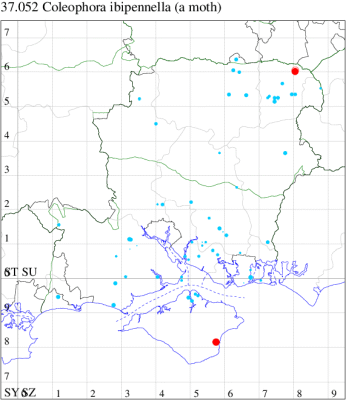
Records by year
Records by week (adult)
Records by week (larval)
Record Details
VC10: Shanklin*, one, gen det, 29 Jun (IOu);
VC12: Yateley*, one, ♂, gen det, 23 Jun (JHH det. AMD)
37.053 [B&F: 0536] Coleophora betulella Heinemann, [1876] - Local
Local in heathland and birch woodland throughout much of England, southern Wales and western Ireland. In Hampshire fairly well-distributed in the north and south of the county, but apparently absent in central Hampshire east of Winchester. Not recorded from the Isle of Wight to date. Wingspan 10-15 mm. Thoroughly confused with C. ibipennella in the past. Like many of the Coleophora, imagines are virtually impossible to identify without recourse to dissection, and the larvae, which live in cases of characteristic form and which can sometimes be found on the foodplant, may be easier to identify by comparison against a reference collection. Larva mines leaves of Birch, subsequently living within a movable pistol-case.
Records prior to 2020
| Vice County | #Records | #Individuals | First Record | Last Record |
|---|---|---|---|---|
| 11 | 33 | 27 | 1980 | 2019 |
| 12 | 17 | 21 | 1980 | 2018 |
2020 records
| Vice County | #Records | #Individuals | Max Quantity |
|---|---|---|---|
| 12 | 1 | 1 | 1 |

Records by year
Records by week (adult)
Records by week (larval)
Record Details
VC12: Pamber Forest, one, 15 Jun (GJD); Castle Bottom NNR, one, ♂, gen det, 25 Jun (JHH, AMD det. AMD)
37.055 [B&F: 0541] Coleophora pyrrhulipennella Zeller, 1839 - Local
Local on heathland, moorland and bogs throughout much of Britain, north to the Great Glen. In Hampshire there are recent records from the New Forest, Wickham Common Pamber Forest and the north-eastern heaths, elsewhere there are scattered records from south-east Hampshire and the Isle of Wight. Wingspan 11-14.5 mm. One of the more distinctive Coleophora. Larva feeds on leaves of Heather and Bell Heather, living within a movable case; case length 9 mm.
Records prior to 2020
| Vice County | #Records | #Individuals | First Record | Last Record |
|---|---|---|---|---|
| 10 | 4 | 11 | 1969 | 2015 |
| 11 | 39 | 55 | 1978 | 2014 |
| 12 | 12 | 8 | 1980 | 2010 |
2020 records
| Vice County | #Records | #Individuals | Max Quantity |
|---|---|---|---|
| 12 | 1 | 1 | 1 |
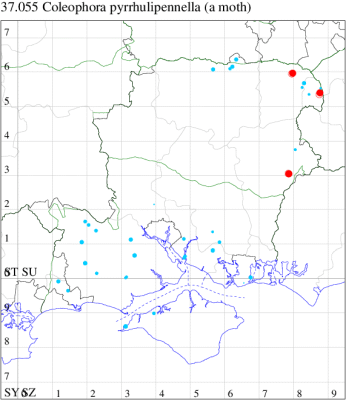
Records by year
Records by week (adult)
Records by week (larval)
Record Details
VC12: Liss Common*, larva, one, netted, larval case found on purple moor-grass among heather, 16 Jun; Castle Bottom NNR*, one, ♂, gen det, 25 Jun (JHH, AMD det. AMD); Farnborough, one, 09 May (KBW)
37.059 [B&F: 0538] Coleophora vibicella (Hübner, [1813]) - pRDB2
Vulnerable (proposed as a future Red Data Book species) in rough pastures and woodland rides, declining, and now probably restricted to Hampshire and adjoining counties, a priority species under the UK Biodiversity Action Plan. In Hampshire recorded recently from Beaulieu, Hayling Island, Stubbington and, most notably, Botley Wood; on the Isle of Wight recorded recently only from Newtown NR. Wingspan 17-22 mm. Almost always recorded in the larval stage, when the cases are fairly easy to find where they are present; the adult can only be separated from similar Coleophora by dissection of the genitalia. Larva mines leaves of Dyer's Greenweed, living within a movable case; case length 19 mm.
Records prior to 2020
| Vice County | #Records | #Individuals | First Record | Last Record |
|---|---|---|---|---|
| 10 | 77 | 2549 | 1900 | 2019 |
| 11 | 63 | 730 | 1900 | 2017 |
2020 records
| Vice County | #Records | #Individuals | Max Quantity |
|---|---|---|---|
| 10 | 3 | 64 | 50 |
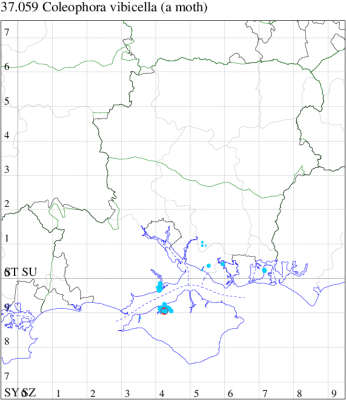
Records by year
Records by week (adult)
Records by week (larval)
Record Details
VC10: Newtown Meadows, larva, 13, field observation, larval cases on Dyer's Greenweed, 17 May; larva, 50, field observation, 11 Jul; one, field observation, emerged from larval case collected, 29 Jul (IOu)
37.061 [B&F: 0530] Coleophora lixella Zeller, 1849 - Nationally Scarce B
Nationally scarce (Nb) on downland, calcareous grassland, sand-dunes and rocky slopes in parts of the British Isles, predominantly coastal in the north of its range. Restricted in Hampshire to a handful of sites, including Porton Down, Oxenbourne, Portsdown, Leckford, Micheldever Spoil Heaps, Lower Test Marshes and Broughton Down. Recorded on the Isle of Wight at Freshwater in 2011, for the first time in over a century. Wingspan 16-21 mm. Flies in afternoon sunshine and at night. Similar to Basil-thyme Case-bearer C. tricolor, but with upperside of apical portion of antenna white (MBGBI Vol 3). Larva mines leaves of Wild Thyme and various grasses, living within a movable case; case length 11 mm.
Records prior to 2020
| Vice County | #Records | #Individuals | First Record | Last Record |
|---|---|---|---|---|
| 10 | 9 | 14 | 1900 | 2019 |
| 11 | 18 | 14 | 1900 | 2019 |
| 12 | 20 | 7 | 1971 | 2013 |
2020 records
| Vice County | #Records | #Individuals | Max Quantity |
|---|---|---|---|
| 11 | 1 | 1 | 1 |

Records by year
Records by week (adult)
Records by week (larval)
Record Details
VC11: Sway, one, 8+mm forewing. Photo?, 24 Jun; one, 8+mm forewing. Photo?, 01 Jul (SKe)
37.063 [B&F: 0544] Coleophora albicosta (Haworth, 1828) - Common
Common in rough grassland, downland and heathland throughout much of the British Isles. In Hampshire common in the south, and on the heaths in the north-east of the county, with scattered records elsewhere; no recent records from the Isle of Wight. Wingspan 12-15.5 mm. Imago is one of the more easily recognisable species, and well-marked specimens may safely be identified without recourse to dissection. Larva feeds within seedpods of Gorse, living within a movable case.
Records prior to 2020
| Vice County | #Records | #Individuals | First Record | Last Record |
|---|---|---|---|---|
| 10 | 7 | 3 | 1937 | 2015 |
| 11 | 198 | 318 | 1971 | 2019 |
| 12 | 36 | 54 | 1971 | 2018 |
2020 records
| Vice County | #Records | #Individuals | Max Quantity |
|---|---|---|---|
| 10 | 1 | 1 | 1 |
| 11 | 2 | 2 | 1 |
| 12 | 11 | 13 | 3 |
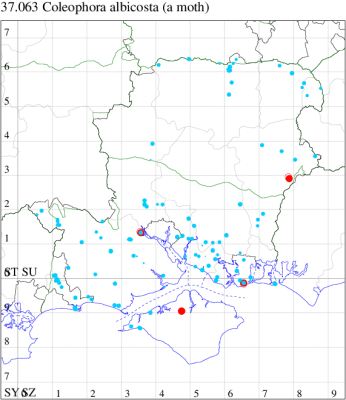
Records by year
Records by week (adult)
Records by week (larval)
Record Details
VC10: Parkhurst Forest, one, gen det, 19 May (IOu);
VC11: Totton, one, 15 Jun (LH); Southsea, one, 26 May (JRL);
VC12: Liss Forest*, one, 04 May; one, 10 May; three, 10 May; one, 10 May; one, 10 May; one, 17 May; one, 21 May; one, 25 May; one, 25 May; one, 25 May; one, 25 May (RJM)
37.069 [B&F: 0587] Coleophora caespititiella Zeller, 1839 - Common
Common in woodland clearings, damp meadows and marshes, both salt and fresh-water, throughout much of England, Wales and southern Ireland. In Hampshire widespread; the paucity of records from the Isle of Wight no doubt reflects historical under-recording, as evidenced by an increase in known range in recent years. Wingspan 8-10 mm. Like many of the Coleophora, imagines are virtually impossible to identify without recourse to dissection. Larva feeds within seed capsules of Compact Rush, Soft-rush, Jointed Rush, Hard Rush and Saltmarsh Rush, subsequently living within a movable case.
Records prior to 2020
| Vice County | #Records | #Individuals | First Record | Last Record |
|---|---|---|---|---|
| 10 | 3 | 0 | 1850 | 2005 |
| 11 | 461 | 1456 | 1972 | 2019 |
| 12 | 42 | 55 | 1995 | 2018 |
2020 records
| Vice County | #Records | #Individuals | Max Quantity |
|---|---|---|---|
| 10 | 1 | 1 | 1 |
| 11 | 5 | 14 | 8 |
| 12 | 1 | 1 | 1 |

Records by year
Records by week (adult)
Records by week (larval)
Record Details
VC10: Shanklin*, one, gen det, 26 May (IOu);
VC11: Portsmouth, one, gen det, 26 May; eight, gen det, 27 May (IRT); Southsea, three, 26 May; one, 27 May; one, 30 May (JRL);
VC12: Warren Hill, Liss Forest, one, gen det, 30 May (RJM)
37.071 [B&F: 0582] Coleophora glaucicolella Wood, 1892 - Common
Common in marshes, fens, damp meadows, woodland rides and saltmarshes throughout much of the British Isles. In Hampshire and on the Isle of Wight occurs principally in the south of the county and the north of the Island, with isolated records in the north of the county, at Sherborne St John, Fleet Pond, Eelmoor Marsh and Winnall Moor. Wingspan 10-12 mm. Very similar to C. alticolella. Like many of the Coleophora, imagines are virtually impossible to identify without recourse to dissection, and the larvae, which live in cases of characteristic form and which can sometimes be found on the foodplant, may be easier to identify by comparison against a reference collection. Larva feeds on seeds of Compact Rush, Soft-rush, Hard Rush and Saltmarsh Rush, living within a movable case.
Records prior to 2020
| Vice County | #Records | #Individuals | First Record | Last Record |
|---|---|---|---|---|
| 10 | 16 | 4 | 1850 | 2010 |
| 11 | 233 | 305 | 1973 | 2019 |
| 12 | 10 | 5 | 1987 | 2008 |
2020 records
| Vice County | #Records | #Individuals | Max Quantity |
|---|---|---|---|
| 10 | 1 | 1 | 1 |
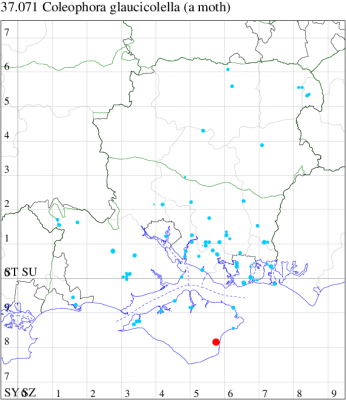
Records by year
Records by week (adult)
Records by week (larval)
Record Details
VC10: Shanklin*, one, gen det, 09 Jun (IOu)
37.072 [B&F: 0578] Coleophora otidipennella (Hübner, [1817]) - Common
Local in grassland, downland, heathland and woodland rides throughout much of the British Isles. In Hampshire recorded from Pamber Heath and Botley Wood, with scattered records elsewhere in the county; there have been a few records from the Isle of Wight. Wingspan 10-13 mm. Like many of the Coleophora, imagines are virtually impossible to identify without recourse to dissection, and the larvae, which live in cases of characteristic form and which can sometimes be found on the foodplant, may be easier to identify by comparison against a reference collection. Larva feeds on seeds of Field Wood-rush and Heath Wood-rush, living within a movable case.
Records prior to 2020
| Vice County | #Records | #Individuals | First Record | Last Record |
|---|---|---|---|---|
| 10 | 1 | 1 | 1967 | 1967 |
| 11 | 41 | 58 | 1974 | 2014 |
| 12 | 8 | 19 | 1976 | 2010 |
2020 records
| Vice County | #Records | #Individuals | Max Quantity |
|---|---|---|---|
| 12 | 2 | 4 | 3 |

Records by year
Records by week (adult)
Records by week (larval)
Record Details
VC12: Liss Forest*, one, 10 May; three, 10 May (RJM)
37.073 [B&F: 0584] Coleophora alticolella Zeller, 1849 - Common
Common on heathland, damp meadows, marshes and a wide range of other habitats throughout much of the British Isles. Probably the most ubiquitous species of Coleophora occurring in the British Isles, having been recorded from almost every county and often in great abundance (MBGBI Vol 3). In Hampshire and on the Isle of Wight widespread and common, most frequent in the south-east. Wingspan 10-12 mm. Very similar to C. glaucicolella. Like many of the Coleophora, imagines are virtually impossible to identify without recourse to dissection, and the larvae, which live in cases of characteristic form and which can sometimes be found on the foodplant, may be easier to identify by comparison against a reference collection. Larva feeds on seeds of Soft-rush and Heath Rush, living within a movable case.
Records prior to 2020
| Vice County | #Records | #Individuals | First Record | Last Record |
|---|---|---|---|---|
| 10 | 38 | 18 | 1926 | 2016 |
| 11 | 355 | 661 | 1971 | 2019 |
| 12 | 36 | 27 | 1992 | 2011 |
2020 records
| Vice County | #Records | #Individuals | Max Quantity |
|---|---|---|---|
| 10 | 1 | 0 | 0 |
| 11 | 1 | 1 | 1 |
| 12 | 5 | 5 | 1 |

Records by year
Records by week (adult)
Records by week (larval)
Record Details
VC10: Hampstead, larva, present, field observation, larval cases, with larvae, on heads of Juncus sp, 23 Sep (PBa);
VC11: Hen Wood, one, ♀, gen det, 24 Jul (F.M.G.);
VC12: Liss Forest, one, 25 May; one, 25 May; one, 25 May; Warren Hill, Liss Forest, one, 14 Jun; one, 14 Jun (RJM)
37.074 [B&F: 0581] Coleophora taeniipennella Herrich-Schäffer, 1855 - Common
Common in fens, damp meadows and marshes throughout much of the British Isles. In Hampshire almost certainly under-recorded within other Juncus-feeding species, but recorded from areas such the New Forest, Botley Wood and Pamber Forest; recent work has found it to be relatively frequent in the west of the Isle of Wight. Wingspan 9-12 mm. Like many of the Coleophora, imagines are virtually impossible to identify without recourse to dissection, and best recorded by searching for the larvae, which live in cases of characteristic form on seeds of Jointed Rush and Sharp-flowered Rush.
Records prior to 2020
| Vice County | #Records | #Individuals | First Record | Last Record |
|---|---|---|---|---|
| 10 | 1 | 1 | 1978 | 1978 |
| 11 | 73 | 48 | 1973 | 2019 |
| 12 | 7 | 4 | 1975 | 2013 |
2020 records
| Vice County | #Records | #Individuals | Max Quantity |
|---|---|---|---|
| 11 | 2 | 2 | 1 |
| 12 | 1 | 1 | 1 |

Records by year
Records by week (adult)
Records by week (larval)
Record Details
VC11: Pig Bush, NF, one, gen det, 17 Jul; Culverley, NF, one, gen det, 19 Jul (CL);
VC12: Warren Hill, Liss Forest*, one, 01 Aug (RJM)
37.077 [B&F: 0552] Coleophora lassella Staudinger, 1859 - Nationally Scarce B
Nationally scarce (Nb) in bare muddy places and sand-dunes in the south-western counties of England and Ireland, and the Channel Island. In Hampshire mainly restricted to the south-east corner of the county, with a few records from bogs in the New Forest; on the Isle of Wight, recorded at Yarmouth in 1992, but not subsequently. Wingspan 10-12 mm. Like many of the Coleophora, imagines are virtually impossible to identify without recourse to dissection, and the larvae, which live in cases of characteristic form and which can sometimes be found on the foodplant, may be easier to identify by comparison against a reference collection. Larva feeds within seed capsules of Toad Rush, living within a movable case.
Records prior to 2020
| Vice County | #Records | #Individuals | First Record | Last Record |
|---|---|---|---|---|
| 10 | 1 | 0 | 1992 | 1992 |
| 11 | 47 | 51 | 1968 | 2019 |
2020 records
| Vice County | #Records | #Individuals | Max Quantity |
|---|---|---|---|
| 11 | 3 | 3 | 1 |

Records by year
Records by week (adult)
Records by week (larval)
Record Details
VC11: Portsmouth, one, gen det, 21 May; one, gen det, 26 May; one, gen det, 06 Aug (IRT)
37.080 [B&F: 0564] Coleophora virgaureae Stainton, 1857 - Nationally Scarce B
Nationally scarce (Nb) in woodland, grassland, cliffs, sand-dunes and saltmarshes throughout much of the British Isles, reaching the Orkney Islands, but very rare or absent from the eastern and east Midland counties (MBGBI Vol 3). In Hampshire largely restricted to areas such as Parnholt Wood, Botley Wood and Havant Thicket, and rare on the coast; there have been a few recent records from the New Forest. Recorded on the Isle of Wight for the first time in over 50 years at Parkhurst Forest in 2010. Wingspan 10-13 mm. Like many of the Coleophora, imagines are virtually impossible to identify without recourse to dissection, and the larvae, which live in cases of characteristic form and which can sometimes be found on the foodplant, may be easier to identify by comparison against a reference collection. Larva feeds on seeds of Goldenrod and Sea Aster, living within a movable case. The case is similar to that C. asteris.
Records prior to 2020
| Vice County | #Records | #Individuals | First Record | Last Record |
|---|---|---|---|---|
| 10 | 5 | 3 | 1947 | 2013 |
| 11 | 16 | 15 | 1972 | 2016 |
2020 records
| Vice County | #Records | #Individuals | Max Quantity |
|---|

Records by year
Records by week (adult)
Records by week (larval)
Record Details
VC11: Chandlers Ford*, one, gen det, 11 Aug; one, gen.det., 11 Aug (BE)
37.083 [B&F: 0565] Coleophora saxicolella (Duponchel, [1843]) - Local
Local on waste ground, farmland and rough ground throughout much of the British Isles, but not in the Highlands or Islands of Scotland. In Hampshire widely distributed in small numbers, mainly inland; recorded once on the Isle of Wight, to light at Ventnor in August 1987. Wingspan 13-16 mm. Imago very similar to C. sternipennella, from which only reliably separated by dissection of the genitalia. Larva feeds on seeds of Orache and Goosefoot, living within a movable case. Case indistinguishable from those of C. sternipennella, C. versurella and C. vestianella.
Records prior to 2020
| Vice County | #Records | #Individuals | First Record | Last Record |
|---|---|---|---|---|
| 10 | 1 | 1 | 1987 | 1987 |
| 11 | 111 | 178 | 1972 | 2019 |
| 12 | 17 | 16 | 1967 | 2017 |
2020 records
| Vice County | #Records | #Individuals | Max Quantity |
|---|---|---|---|
| 11 | 5 | 5 | 1 |
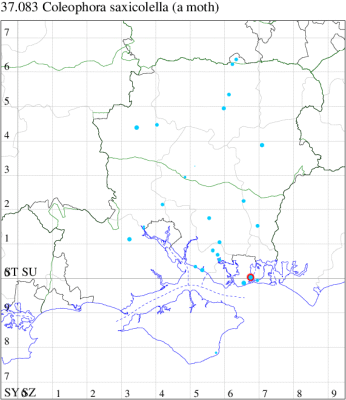
Records by year
Records by week (adult)
Records by week (larval)
Record Details
VC11: Portsmouth, one, gen det, 30 Jul; one, gen det, 03 Aug; one, gen det, 06 Aug; one, gen det, 07 Aug; one, gen det, 18 Aug (IRT)
37.086 [B&F: 0568] Coleophora versurella Zeller, 1849 - Local
Local on saltmarshes, waste ground and farmland in England and Wales, as far north as Co. Durham, and the Isle of Man (MBGBI Vol 3). In Hampshire largely restricted to the south-east coast, but there are a few inland records identified through dissection that indicate it is very likely to be more widespread than records suggest. Certainly, detailed work on the Isle of Wight since 2020 has indicated that it is likely to bre relatively common and under-recorded. Wingspan 11-15 mm. Imago very similar to C. sternipennella, from which only reliably separated by dissection of the genitalia. Larva feeds on seeds of Orache and Goosefoot, living within a movable case. Case indistinguishable from those of href="lep.php?code=37.083">C. saxicolella, C. sternipennella and C. vestianella.
Records prior to 2020
| Vice County | #Records | #Individuals | First Record | Last Record |
|---|---|---|---|---|
| 10 | 1 | 0 | 1938 | 1938 |
| 11 | 76 | 80 | 1968 | 2019 |
| 12 | 9 | 8 | 1965 | 2011 |
2020 records
| Vice County | #Records | #Individuals | Max Quantity |
|---|---|---|---|
| 10 | 1 | 1 | 1 |
| 11 | 1 | 1 | 1 |

Records by year
Records by week (adult)
Records by week (larval)
Record Details
VC10: Ventnor Botanic Garden*, one, to actinic, gen det, 29 Sep (PBa);
VC11: Portsmouth, one, gen det, 30 Jul (IRT)
37.093 [B&F: 0559] Coleophora peribenanderi Toll, 1943 - Common
Common in rough grassland, waste ground, roadside verges and woodland rides throughout much of England and Wales, rare elsewhere. In Hampshire common in the south-east, but otherwise only sparsely recorded and apparently absent from the New Forest; on the Isle of Wight, generally uncommon. Wingspan 12.5-15 mm. Very similar to C. therinella, from which only separated in 1942. Like many of the Coleophora, imagines are virtually impossible to identify without recourse to dissection, and the larvae, which live in cases of characteristic form and which can sometimes be found on the foodplant, may be easier to identify by comparison against a reference collection. Larva mines leaves of Carduus, Cirsium and Arctium, living within a movable case.
Records prior to 2020
| Vice County | #Records | #Individuals | First Record | Last Record |
|---|---|---|---|---|
| 10 | 5 | 2 | 1981 | 2019 |
| 11 | 200 | 223 | 1975 | 2019 |
| 12 | 17 | 8 | 1982 | 2010 |
2020 records
| Vice County | #Records | #Individuals | Max Quantity |
|---|---|---|---|
| 10 | 1 | 1 | 1 |
| 11 | 2 | 2 | 1 |

Records by year
Records by week (adult)
Records by week (larval)
Record Details
VC10: Shanklin, one, gen det, 22 Jun (IOu);
VC11: Portsmouth, one, gen det, 14 Jun; one, gen det, 30 Jul (IRT)
37.099 [B&F: 0553] Coleophora striatipennella Nylander [1848] - Common
Common in rough grassland, waste ground, woodland rides, damp woodland, marshes, river-banks and other damp areas throughout much of the British Isles. In Hampshire fairly well-distributed, with the usual concentration of records in the south-east, probably under-recorded elsewhere. First recorded on the Isle of Wight at Brighstone Down in 2009. Wingspan 11-13 mm. Like many of the Coleophora, imagines are virtually impossible to identify without recourse to dissection, and the larvae, which live in cases of characteristic form and which can sometimes be found on the foodplant, may be easier to identify by comparison against a reference collection. Larva feeds within seed capsules of Lesser Stitchwort, Common Chickweed, Common Mouse-ear and Water Chickweed, living within a movable case.
Records prior to 2020
| Vice County | #Records | #Individuals | First Record | Last Record |
|---|---|---|---|---|
| 10 | 4 | 3 | 2009 | 2019 |
| 11 | 118 | 128 | 1972 | 2019 |
| 12 | 25 | 29 | 1981 | 2017 |
2020 records
| Vice County | #Records | #Individuals | Max Quantity |
|---|---|---|---|
| 11 | 1 | 1 | 1 |

Records by year
Records by week (adult)
Records by week (larval)
Record Details
VC11: Winchester, one, 03 May (THW)
37.102 [B&F: 0563] Coleophora argentula (Stephens, 1834) - Common
Common on waste ground and rough grassland, and by ditches and freshwater margins, throughout much of southern England, Wales and central Scotland. In south Hampshire, cases are common to abundant on yarrow, especially near the coast, but recorded less frequently in the north and on the Isle of Wight. Wingspan 9.5-13 mm. More frequently recorded in the larval stage, when the cases are fairly easy to find where they are present; the imago can be separated from several very similar Coleophora species only by dissection of the genitalia. Larva feeds on flowers and seedheads of Yarrow and Sneezewort, living within a movable case; case length 5-6 mm.
Records prior to 2020
| Vice County | #Records | #Individuals | First Record | Last Record |
|---|---|---|---|---|
| 10 | 18 | 14 | 1850 | 2013 |
| 11 | 158 | 109 | 1975 | 2019 |
| 12 | 43 | 20 | 1985 | 2012 |
2020 records
| Vice County | #Records | #Individuals | Max Quantity |
|---|---|---|---|
| 10 | 4 | 0 | 0 |
| 11 | 1 | 1 | 1 |

Records by year
Records by week (adult)
Records by week (larval)
Record Details
VC10: Freshwater, larva, present, field observation, several larval cases on heads of Achillea millefolium, 12 Sep; Freshwater Bay, larva, present, field observation, larval cases on heads of Achillea millefolium, 21 Sep; Hamstead, larva, present, field observation, several cases on heads of Achillea millefolium, 23 Sep; Ventnor Botanic Garden, larva, present, field observation, larval cases on heads of Achillea millefolium, 21 Sep (PBa);
VC11: Portsmouth, one, gen det, 30 Jul (IRT);
VC12: Blackbushe Airfield, larva, 15, field observation, c.15 empty larval cases on dead seedheads of Yarrow, 19 Nov (JHH)
37.108 [B&F: 0588] Coleophora salicorniae Heinemann & Wocke, [1876] - Nationally Scarce B
Nationally scarce (Nb) in saltmarshes along much of the coast of England, from Cornwall to Yorkshire, and in parts of Wales. In Hampshire and on the Isle of Wight restricted to coasts in the south-east of the county and north-west of the Island. Wingspan 12-14 mm. Like many of the Coleophora, imagines are virtually impossible to identify without recourse to dissection, and the larvae, which live in cases of characteristic form and which can sometimes be found on the foodplant, may be easier to identify by comparison against a reference collection. Larva feeds within seeds of Glasswort, living within a movable case, buried in mud.
Records prior to 2020
| Vice County | #Records | #Individuals | First Record | Last Record |
|---|---|---|---|---|
| 10 | 6 | 8 | 1900 | 2019 |
| 11 | 117 | 165 | 1975 | 2019 |
2020 records
| Vice County | #Records | #Individuals | Max Quantity |
|---|---|---|---|
| 11 | 1 | 1 | 1 |

Records by year
Records by week (adult)
Records by week (larval)
Record Details
VC11: Portsmouth, one, gen det, 07 Aug (IRT)




()(IMG_5323).jpg)
(Larval case)(2).jpg)
